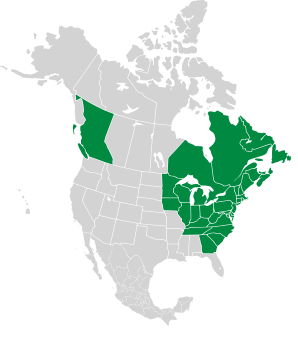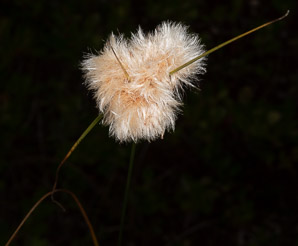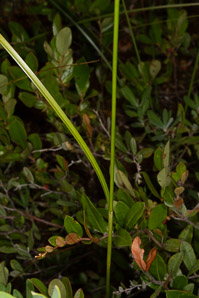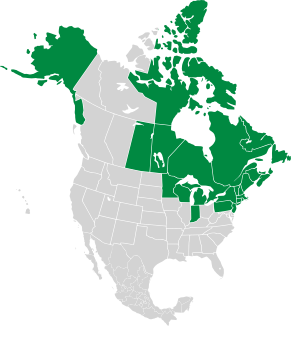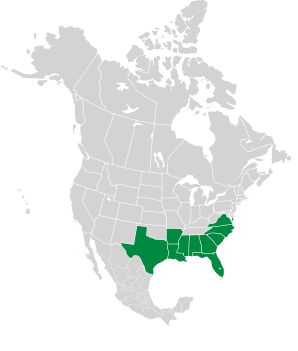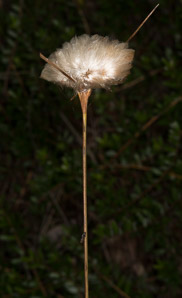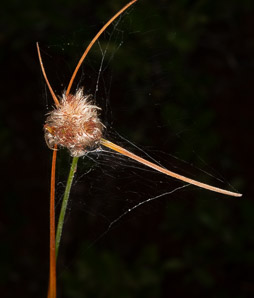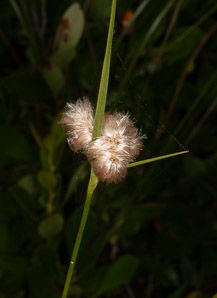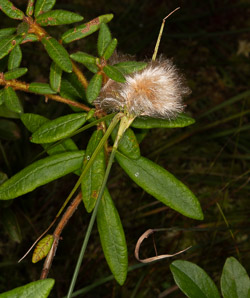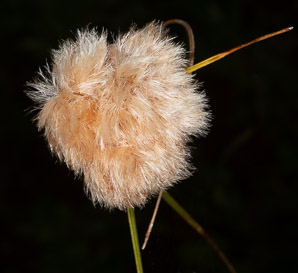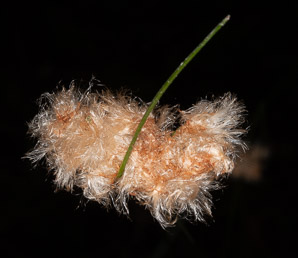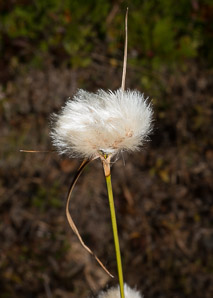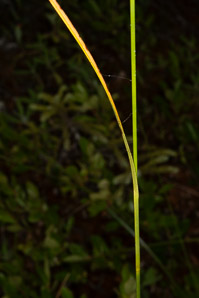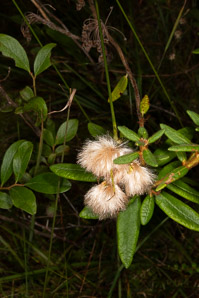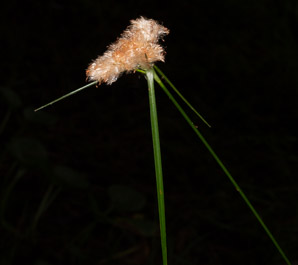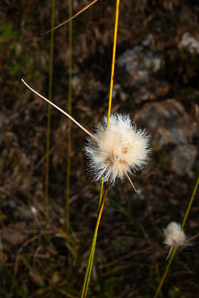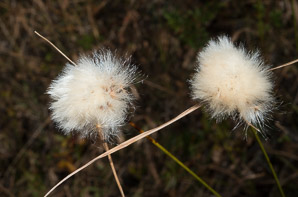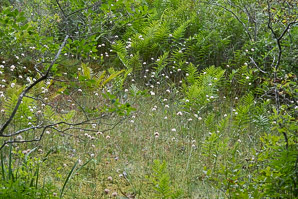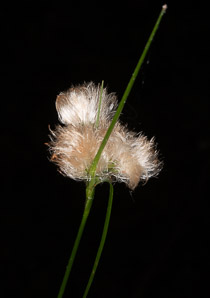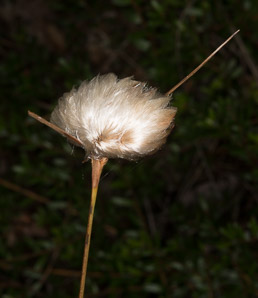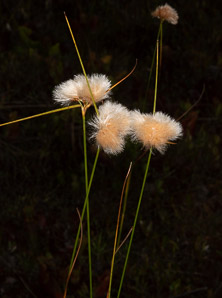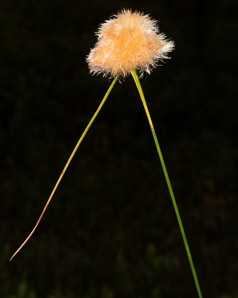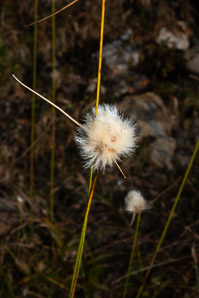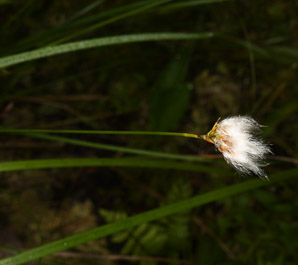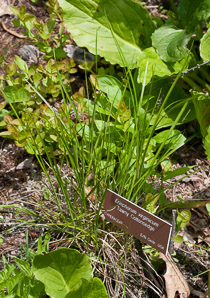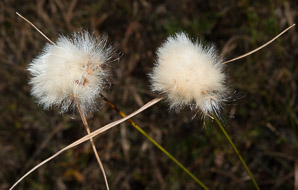
|
Eriophorum virginicum L. Tawny cottonsedge, tawny cotton-grass
Tawny cotton-grass is a North American native plant, found along much of the eastern seaboard and especially in the northeast. It prefers wet, peaty, acidic soil, such as bogs, damp meadows, and conifer swamps. Plants: Stems (culms) are not branched, hairless, and 1-4′ (40-121 cm) in height. They are single, or in small groups, with round or slightly triangular cross sections. Leaves: Alternate, up to 1′ (30 cm) long × 1/32-⅛″ (1.5-4 mm) wide. They are linear, flat at the base, becoming triangular in cross section as they approach the tip, with parallel veins. They may be erect, or floppy. Flowers: Although they often look like a single tuft of cotton, the tuft is comprised of 2-10 densely packed spikelet clusters. The lowermost spikelets are wrapped in leafy bracts, like tiny ears of corn. Each spikelet is ⅛-⅜″ (6-10 mm) long. Ten or more threadlike bristles—the “cotton”—extend from the base of each flower. The threads eventually become up to ¾″ (2 cm) long, usually brown at the base, and somewhere between off white and brown or red-brown as the plant ages. The red-brown color distinguishes tawny cotton-grass from other cotton grasses. (More subtle identifiers include a single stamen per floret instead of 3, and multiple veins on the scales of the seedheads.) Flowers appear from June to September. Fruits: Fruits appear from July to September. The achenes are 1/16-⅛″ (2.5-4 mm) long, shaped like a narrow ellipse with a triangular or rounded cross section. They are brown or black. These are closely similar: |
8/22/2020 · Kettle Hole Bog, Hidden Valley Nature Center, Jefferson, Maine · ≈ 6 × 4″ (16 × 11 cm) 8/22/2020 · Kettle Hole Bog, Hidden Valley Nature Center, Jefferson, Maine · ≈ 4 × 6″ (10 × 15 cm) 8/22/2020 · Kettle Hole Bog, Hidden Valley Nature Center, Jefferson, Maine · ≈ 5 × 8″ (13 × 20 cm) |
||||||||||||||||||||||||||||
|
| |||||||||||||||||||||||||||||
Eriophorum vaginatum var. spissum |
You are here Eriophorum virginicum |
Rhynchospora colorata |
|||||||||||||||||||||||||||
|---|---|---|---|---|---|---|---|---|---|---|---|---|---|---|---|---|---|---|---|---|---|---|---|---|---|---|---|---|---|
| Common Name |  |
 |
 |
||||||||||||||||||||||||||
| Plant | Stems (culms) are round, oval, or triangular in cross section. The stems are very thin, about 11.8 mils (0.3 mm), and densely packed into tussocks. | Stems are not branched, hairless, and 1-4′ (40-121 cm) in height. They are single, or in small groups, with round or slightly triangular cross sections. | Grasslike clumps or solitary plants. Each is topped with a “flower” comprised of 3-10 specialized green and white leaves. The “petals” are really specialized leaves (bracts), each up to 5″ (13 cm) × 1/16-¼″ (2-7 mm). Stems are triangular in cross section. | ||||||||||||||||||||||||||
| Flowers | Flowers appear in a compact cluster at the tip of the stem, appearing elliptic at first, then more hemispheric as the plant matures. If you look closely, the numerous flowerheads are arranged in a spiral pattern. The cottony flowerheads are ¾-2″ (1.9-5 cm) in size, erect (vs. nodding) and are white (vs. brownish). | Although they often look like a single tuft of cotton, the tuft is comprised of 2-10 densely packed spikelet clusters. The lowermost spikelets are wrapped in leafy bracts, like tiny ears of corn. Each spikelet is ⅛-⅜″ (6-10 mm) long. Ten or more threadlike bristles—the “cotton”—extend from the base of each flower. The threads eventually become up to ¾″ (2 cm) long, usually brown at the base, and somewhere between off white and brown or red-brown as the plant ages. The red-brown color distinguishes tawny cotton-grass from other cotton grasses. (More subtle identifiers include a single stamen per floret instead of 3, and multiple veins on the scales of the seedheads.) Flowers appear from Jun to Sep. | A dense cluster of small spikelets ⅛-¼″ (5-7 mm) long, nestled amidst the bracts. Each spikelet is white, ovoid, and contains several tiny flowers. They appear in June and July. | ||||||||||||||||||||||||||
| Leaves | There are a few basal, alternate leaves, and a few higher up, but they are easy to miss amongst the many stems. Each leaf is up to 1/32″ (1 mm) wide, resembling a grass blade, and may be nearly as long as the stem. | Alternate, up to 1′ (30 cm) long × 1/32-⅛″ (1.5-4 mm) wide. They are linear, flat at the base, becoming triangular in cross section as they approach the tip, with parallel veins. They may be erect, or floppy. | Grasslike, linear, arising from the base of the plant in clusters, spreading or erect, 1/32-⅛″ (0.5-3 mm) wide. | ||||||||||||||||||||||||||
| Fruit | 1/16-⅛″ (1.9-3.5 mm) long. They are triangular to rounded in cross-section. White bristles around the base of each flower extend in length, becoming ¼-¾″ (8.3-19 mm) long, producing the “cotton.” Seeds (achenes) are 1/16-⅛″ (1.9-3.5 mm) long, and shaped like teardrops. They are three-sided when viewed in cross section. | Fruits appear from July to September. The achenes are 1/16-⅛″ (2.5-4 mm) long, shaped like a narrow ellipse with a triangular or rounded cross section. They are brown or black. | Spikelets mature to a yellow to mahogony color. Each spikelet contains several fruits, each 1/32-1/16″ (1.5-1.7 mm) in size. Fruits appear in late spring to summer. | ||||||||||||||||||||||||||
| Range/ Zones |
|
|
|
||||||||||||||||||||||||||
| Habitats | Peaty bogs and acidic wetlands. | Wet, peaty, acidic soil, such as bogs, damp meadows, and conifer swamps. | Wet coastal areas, dunes, flatwoods, wet prairies, swales and roadside ditches | ||||||||||||||||||||||||||
| Type | Wild | Wild | Wild | ||||||||||||||||||||||||||
Kyllinga nemoralis

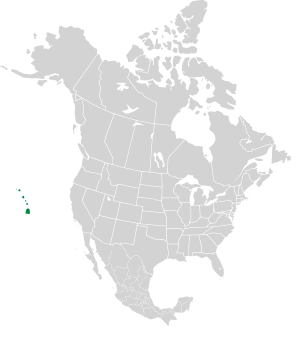
Online References:
The Lady Bird Johnson Wildflower Center
References:
10/8/2016 · Groton Town Forest, Groton, Massachusetts · ≈ 4 × 6″ (11 × 16 cm) 
8/22/2020 · Kettle Hole Bog, Hidden Valley Nature Center, Jefferson, Maine · ≈ 5 × 3½″ (13 × 9.2 cm) 
8/22/2020 · Kettle Hole Bog, Hidden Valley Nature Center, Jefferson, Maine · ≈ 6 × 4″ (15 × 10 cm) 
The leaves are bog Labrador tea (Ledum groenlandicum), not part of the sedge. · 8/22/2020 · Kettle Hole Bog, Hidden Valley Nature Center, Jefferson, Maine · ≈ 4½ × 7″ (12 × 18 cm) 
8/22/2020 · Kettle Hole Bog, Hidden Valley Nature Center, Jefferson, Maine · ≈ 5 × 3½″ (13 × 8.7 cm) 
8/16/2020 · Long Reach Preserve, Harpswell, Maine · ≈ 6 × 4″ (16 × 11 cm) 
9/28/2013 · Cadillac Mountain, Acadia Naitonal Park, Bar Harbor, Maine · ≈ 5 × 8″ (12 × 19 cm) 
8/22/2020 · Kettle Hole Bog, Hidden Valley Nature Center, Jefferson, Maine · ≈ 4 × 6″ (10 × 15 cm) 
The leaves are bog Labrador tea (Ledum groenlandicum), not part of the sedge. · 8/22/2020 · Kettle Hole Bog, Hidden Valley Nature Center, Jefferson, Maine · ≈ 5 × 8″ (13 × 20 cm) 
8/16/2020 · Long Reach Preserve, Harpswell, Maine · ≈ 10 × 6″ (24 × 16 cm) 
9/28/2013 · Cadillac Mountain, Acadia Naitonal Park, Bar Harbor, Maine · ≈ 5 × 8″ (13 × 19 cm) 
Eriophorum virginicum description by Thomas H. Kent, last updated 27 Oct 2023.
© FloraFinder.org. All rights reserved.
9/28/2013 · Cadillac Mountain, Acadia Naitonal Park, Bar Harbor, Maine · ≈ 8 × 5″ (19 × 12 cm) 
8/16/2020 · Long Reach Preserve, Harpswell, Maine 
8/16/2020 · Long Reach Preserve, Harpswell, Maine · ≈ 7 × 4½″ (18 × 12 cm) 
10/8/2016 · Groton Town Forest, Groton, Massachusetts · ≈ 4 × 6″ (11 × 16 cm) 
8/22/2020 · Kettle Hole Bog, Hidden Valley Nature Center, Jefferson, Maine · ≈ 6 × 10″ (16 × 24 cm) 
8/22/2020 · Kettle Hole Bog, Hidden Valley Nature Center, Jefferson, Maine · ≈ 4½ × 7″ (12 × 18 cm) 
9/28/2013 · Cadillac Mountain, Acadia Naitonal Park, Bar Harbor, Maine · ≈ 5 × 8″ (13 × 19 cm) 
9/16/2016 · Sieur de Monts Botanical Gardens, Bar Harbor, Maine 
5/22/2010 · Garden in the Woods, Framingham, Massachusetts · ≈ 1 × 2′ (41 × 62 cm) 
9/28/2013 · Cadillac Mountain, Acadia Naitonal Park, Bar Harbor, Maine · ≈ 8 × 5″ (19 × 12 cm) 
Range: Zones 2-6:
